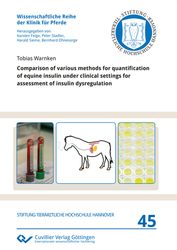| Areas | |
|---|---|
| Serie de libros (96) |
1378
|
| Nachhaltigkeit |
3
|
| Gesundheitswesen |
1
|
| Letra |
2363
|
| Ciencias Naturales |
5406
|
| Matemática | 229 |
| Informática | 319 |
| Física | 980 |
| Química | 1363 |
| Geociencias | 131 |
| Medicina humana | 243 |
| Estomatología | 10 |
| Veterinaria | 108 |
| Farmacia | 147 |
| Biología | 835 |
| Bioquímica, biología molecular, tecnología genética | 121 |
| Biofísica | 25 |
| Nutrición | 45 |
| Agricultura | 1004 |
| Silvicultura | 201 |
| Horticultura | 20 |
| Ecología y conservación de la tierra | 148 |
| Ciencias Ingeniería |
1791
|
| General |
98
|
|
Leitlinien Unfallchirurgie
5. Auflage bestellen |
|
Erweiterte Suche
Comparison of various methods for quantification of equine insulin under clinical settings for assessment of insulin dysregulation (Volumen 45) (Tienda española)
Tobias Warnken (Autor)Previo
Lectura de prueba, PDF (610 KB)
Indice, PDF (580 KB)
The equine metabolic syndrome is a significant problem and health concern in the equine population. Impaired insulin regulation reflected by basal or pathological postprandial hyperinsulinemia and caused by insulin dysregulation (ID) and/or insulin resistance (IR) is the major key finding and clearly linked to the severe and life-threating sequel laminitis. However, besides various diagnostic approaches for assessment of disturbed insulin regulation under basal conditions or under dynamic stimulation, striking differences in performance of immunoassays used for quantification of equine insulin occurred. Therefore, the objective of this research project was firstly to evaluate various methods used for quantification of equine insulin under consideration of clinical demands and conditions and secondly to optimize assessment of equine ID and IR by a combination of appropriate dynamic diagnostic testing and quantification of equine insulin with an reliable and appropriate immunoassay method.
| ISBN-13 (Impresion) | 9783736971240 |
| ISBN-13 (E-Book) | 9783736961241 |
| Formato | A5 |
| Idioma | Inglés |
| Numero de paginas | 140 |
| Laminacion de la cubierta | mate |
| Edicion | 1. |
| Serie | Wissenschaftliche Reihe der Klinik für Pferde |
| Volumen | 45 |
| Lugar de publicacion | Göttingen |
| Lugar de la disertacion | TiHo Hannover |
| Fecha de publicacion | 02.12.2019 |
| Clasificacion simple | Tesis doctoral |
| Area |
Veterinaria
Veterinaria específica |
| Palabras claves | metabolic syndrome, insulin dysregulation, equine population |








